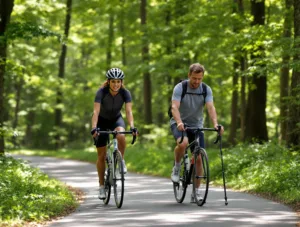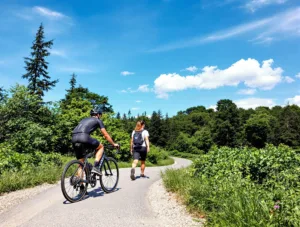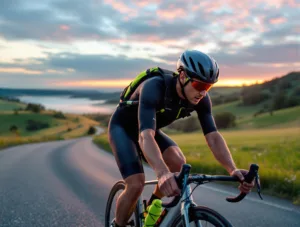Does Cycling Help Get Rid of Belly and Butt Fat? Targeting Localized Fat and Exercise Effectiveness
Introduction
In the quest for a toned midsection and a firmer backside, many people turn to cycling as a potential solution. But does cycling actually help reduce stubborn belly and butt fat, or is it just another fitness myth? The debate over spot reduction—losing fat in specific areas through targeted exercises—has been ongoing for years. While cycling is an excellent cardiovascular workout that burns calories and strengthens muscles, its direct impact on localized fat loss is more complex.
This article explores the science behind fat loss, the role of cycling in weight management, and whether it can effectively trim belly and butt fat. We’ll also examine complementary strategies for achieving a leaner physique, including diet, strength training, and overall lifestyle adjustments.
Understanding Fat Loss: The Myth of Spot Reduction
How the Body Burns Fat
The human body stores fat in adipose tissue, which is distributed based on genetics, hormones, and lifestyle factors. When you engage in physical activity, the body taps into energy reserves, breaking down fat from all over—not just the area being worked. This means that doing endless crunches won’t necessarily shrink belly fat, just as cycling alone won’t magically melt butt fat.
Why Spot Reduction Doesn’t Work
Scientific studies consistently show that targeted fat loss is a myth. A 2013 study published in the Journal of Strength and Conditioning Research found that participants who performed ab exercises for six weeks showed no significant reduction in belly fat compared to a control group. Similarly, cycling strengthens and tones the glutes, hamstrings, and quadriceps, but fat loss occurs systemically, not locally.
The Role of Genetics and Hormones
Where your body stores and loses fat first is largely determined by genetics and hormones. Men tend to accumulate fat around the abdomen (android obesity), while women often store it in the hips, thighs, and buttocks (gynoid obesity). This explains why some people may lose face or arm fat quickly but struggle with stubborn belly or butt fat.
Cycling for Fat Loss: Benefits and Limitations
Caloric Burn and Weight Management
Cycling is an effective way to burn calories, which is essential for overall fat loss. Depending on intensity and body weight, a person can burn between 400–1000 calories per hour while cycling. Over time, maintaining a calorie deficit (burning more than you consume) leads to fat reduction across the body, including the belly and butt.
Muscle Toning vs. Fat Loss
While cycling won’t spot-reduce fat, it does build muscle in the lower body. Stronger glutes, quadriceps, and hamstrings can create a more toned appearance, making the butt and thighs look firmer. However, if a layer of fat covers these muscles, they may not be visibly defined until overall body fat percentage decreases.
Types of Cycling for Maximum Fat Burn
- High-Intensity Interval Training (HIIT) Cycling: Short bursts of maximum effort followed by recovery periods boost metabolism and enhance fat burning.
- Endurance Cycling: Long, steady rides improve cardiovascular health and endurance, contributing to calorie expenditure.
- Hill Cycling: Riding uphill engages the glutes and core more intensely, increasing muscle activation.
Complementary Strategies for Losing Belly and Butt Fat
Since cycling alone isn’t enough for significant fat loss in specific areas, combining it with other strategies yields better results.
1. Strength Training for a Balanced Physique
Incorporating resistance training (squats, deadlifts, lunges) helps build muscle, which increases resting metabolic rate. More muscle means more calories burned even at rest, aiding fat loss.
2. Core Workouts for a Flatter Stomach
While crunches won’t spot-reduce belly fat, strengthening the core (planks, leg raises, Russian twists) improves posture and muscle definition, making the waist appear slimmer as fat decreases.
3. Diet: The Key to Unlocking Fat Loss
No amount of exercise can outwork a poor diet. Key dietary tips include:
- Prioritizing protein to preserve muscle mass.
- Reducing refined carbs and sugars to prevent fat storage.
- Eating healthy fats (avocados, nuts, olive oil) to support metabolism.
- Staying hydrated to optimize fat-burning processes.
4. Consistency and Progressive Overload
To see continuous fat loss, gradually increase cycling intensity, duration, or resistance. The body adapts to repetitive workouts, so challenging it prevents plateaus.
Final Verdict: Can Cycling Trim Belly and Butt Fat?
Cycling is an excellent exercise for overall fat loss, cardiovascular health, and lower-body toning. However, it cannot selectively burn belly or butt fat—no exercise can. Fat reduction happens systemically, meaning you’ll lose fat from all over your body as you maintain a calorie deficit.
For best results:✅ Combine cycling with strength training to build muscle and boost metabolism.✅ Follow a balanced, calorie-controlled diet to support fat loss.✅ Stay consistent and incorporate HIIT or hill cycling for maximum calorie burn.✅ Be patient—genetics play a role in where fat is lost first.
Conclusion
While cycling alone won’t magically shrink belly and butt fat, it is a powerful tool in a comprehensive fat-loss strategy. By combining regular cycling with strength training, a nutritious diet, and other healthy habits, you can achieve a leaner, more toned physique. Remember, sustainable fat loss takes time, consistency, and a holistic approach—so keep pedaling, stay disciplined, and the results will follow.
Would you like a personalized cycling and nutrition plan to maximize fat loss? Consult a fitness professional to tailor a program to your goals! 🚴♂️💪









Add comment